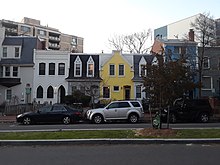
Housing in Washington, D.C., encompasses a variety of shelter types: apartments, single family homes, condominiums, co-ops, and apartments considered public housing. [1] Washington, D.C., is considered one of the most expensive cities in which to live in the United States—in 2019, it was ranked in the top 10 of American cities with the most expensive homes. [2] [3]
History
The oldest residential house in Washington, D.C., was built in 1754, and originally located in Danvers, Massachusetts. The home was dismantled, shipped to D.C. by railcar and reconstructed in the Kalorama neighborhood. [4]
Residential homes throughout the city were built in a variety of architectural styles, including Federal, Victorian, Tudor revival, Beaux Arts, Arts and Crafts, Bungalow, Colonial, and contemporary. [5]
Racial segregation
Black settlement was legally barred in many areas of Washington, D.C., through the first half of the 20th century due to racially restrictive deed covenants which barred Black home seekers from purchasing. [6] [7] By the 1920s, neighborhood associations would gather signatures to place such racially restrictive covenants on the properties of signers, which would restrict entire neighborhoods. Neighborhoods like Mount Pleasant and Bloomingdale were particularly affected. [7] Further, Black homebuyers routinely overpaid for homes in the city, and integrated neighborhoods were rare. [6]
As of 1960, the segregation was deeply felt—2.2% of new houses in the city were available to Black residents. Washington, D.C., introduced policies to prohibit discrimination in 1964. [6]
Neighborhood advocacy groups
There have been a number of groups formed to combat housing segregation in Washington, D.C., In 1958, an interracial group of residents of the Manor Park neighborhood created the Neighbors Inc. group to encourage the integration of their neighborhood—particularly attracting white residents. Other such advocacy groups that lobbied for integrated neighborhoods and changes in housing policy included Northwest Washington Fair Housing, Suburban Maryland Fair Housing, Prince George's County Fair Housing, and Northern Virginia Fair Housing. [6]
Affordability
Median home value in Washington, D.C., as of 2020, was $617,900, making the city the #4 most expensive in the country. Rents and mortgages are 2.8 times higher than the national average. [3] The median rent in 2018 was $1,487. [8]
Public housing

Public housing appeared in Washington, D.C., after the passage of the National Housing Act in 1934. Langston Terrace Dwellings, an all-Black community with 274 units built from 1935 to 1938, was the nation's second public housing project undertaken in the country. Hilyard Robinson, a Black architect and Washington native, designed the building. The Langston Terrace Dwellings were added to the DC Inventory of Historic Sites in 1986 and the National Register of Historic Places in 1987. [9]
Homelessness
The homeless population decreased by 5.5% from 2018 to 2019, according to the Joint Center for Housing Studies at Harvard University. In 2019, there were a reported 6,521 people experiencing homelessness in Washington, D.C. [10] In 2021, Washington D.C., had the highest rate of homelessness, having 90.4 homeless persons per 10,000 people. [11]
References
- ^ "Types of Housing | edscape". edscape.dc.gov. Retrieved 2020-12-13.
- ^ Dishman, Lydia (2019-11-04). "These 10 cities have the most expensive homes in America right now". Fast Company. Retrieved 2020-12-13.
- ^ a b "The 20 Most Expensive Cities in the U.S." Kiplinger. Retrieved 2020-12-13.
- ^ Izon, Juliet. "Inside the Oldest House in Washington, D.C." Architectural Digest. Retrieved 2020-12-13.
- ^ "Tudor, Federal, Bungalows: Taking Stock of DC's Architectural Styles". UrbanTurf. Retrieved 2020-12-13.
- ^ a b c d "Race and real estate in mid-century D.C." D.C. Policy Center. Retrieved 2020-12-13.
- ^ a b "Story Map Journal". www.arcgis.com. Retrieved 2020-12-13.
- ^ "Maps & Data". www.povertyusa.org. Retrieved 2020-12-13.
- ^ Perry-Brown, Nena (May 29, 2020). "A brew of advocacy and agency concocted the US public housing system that we know today". Greater Greater Washington. Retrieved 2020-12-13.
- ^ "Homelessness Increased in Both High- and Low-Cost States in 2019 | Joint Center for Housing Studies". www.jchs.harvard.edu. Retrieved 2020-12-13.
- ^ "U.S. homeless rates by state 2019". Statista. Retrieved 7 January 2022.
Further reading
- Samantha Schmidt (December 29, 2020), "As homeless shelters brace for funding cuts, LGBTQ youths take desperate measures to get by", Washington Post